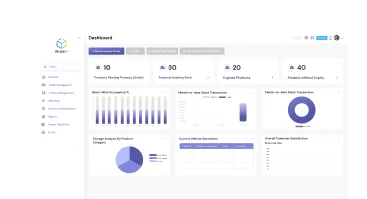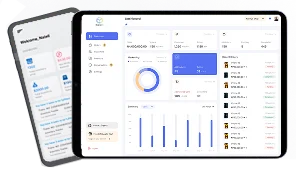![Ecommerce WMS Cost Explained [Don’t Overpay in 2025]](https://warego.co/blog/wp-content/uploads/2025/07/Ecommerce-Warehouse-Management-System-Cost.jpg)
The eCommerce market is competitive.
Currently, there are approximately 30.7 million eCommerce websites in operation worldwide. And business owners like you need to deliver exceptional services to make a lasting impression in such a competitive market.
With an ecommerce warehouse management system, you can manage the warehouse efficiently, sort inventory without manual errors, and deliver orders in a timely manner, all while paying less for overall ecommerce business operations.
But, how much does ecommerce wms cost? Let’s learn about it in this blog and take the first step towards growth and customer satisfaction.
With as low as $449, add automation, accuracy, scalability, and efficiency to your eCommerce business operations.
Start NowTable of Contents
Why Should Businesses Invest in Ecommerce WMS?
Ecommerce business operations are becoming complex with every passing year.
Today, businesses are dealing with:
- Multi channel selling including separate platforms like Shopify, Amazon, Walmart, Etsy along with their own websites.
- High customer expectations like same day, or max 2 day delivery, order tracking, and more.
- Thousands of SKUs, including sizes, colors, and other variants.
- Increasing return rates, up to 30% to 40%.
- More and more ecommerce companies are taking 3PL companies onboard for logistics management.
- Selling cross borders/dealing with different warehouses, currencies, customs, and shipping providers.
- Depend on analytics and data to make informed decisions.
To manage all these complexities, an ecommerce wms is necessary.
Since there are different vendors claiming to provide the best services, it is essential to understand key cost factors to avoid hidden charges and pay relevant fees to implement a functional software system.
How Much Does Ecommerce WMS Cost?
The ecommerce wms cost depends on the type of software deployment you select. The standard deployment types include cloud-based and on-premises.
To confirm you select the right deployment type and a cost-effective e-commerce WMS, this section outlines the costs, pros, and cons of each deployment type, as well as identifies which companies each deployment type is best suited for.
1. Cloud-Based (Software-as-a-Service – SaaS)
Cloud based ecommerce WMS software uses a subscription model that charges businesses every month on the basis of the package they have selected. Generally, vendors offer tiered pricing to help businesses select a price according to their budget.
For a standard package of cloud-based e-commerce WMS, you can expect to pay $ 449 per month for 25 users. For the Pro package, you will pay $779 per month for 50 users, and for the Advanced package, you are likely to pay $ 1,149 per month for 100 users.
Every package includes a specific number of users, LPNs per month, facilities, and the number of SKUs to be processed. Therefore, before you choose, thoroughly understand the package.
Pros | Cons |
| Less to no upfront costs | A constant requirement of high-speed internet |
| Good scalability and worldwide accessibility | Less control over infrastructure and constant collaboration with the vendor |
| Automatic updates and quick maintenance processes | |
| Fast deployment and instant getting started |
Best for:
- Multi-Channel E-commerce Sellers
- Small to medium sized businesses
- businesses with budget constraints
- Businesses with Fluctuating or Seasonal Demand
- Businesses with Multiple Warehouse Locations or 3PL Partnerships
- Businesses Prioritizing Speed and Agility
- Businesses Looking to Reduce Total Cost of Ownership
Switch to WareGo and get more features, less stress, and better pricing.
View Pricing2. On-Premises (Licensed)
An on-premises ecommerce WMS software is a solution that is installed directly into your company’s servers and hardware, unlike a cloud-based system that is hosted in the cloud.
The cost of on-premises software is a combination of multiple factors.
When you select an on-premises software solution, expect to pay an upfront license fees ($20,000 to $100,000+), hardware & infrastructure fees ($10,000 to $50,000), implementation & customization ($10,000 to $80,000), IT personnel or external consultants ($40,000–$100,000/year), maintenance & support (15%–25% of license cost/annually), and upgrade costs (major versions require a separate fee)
The ecommerce wms costs vary depending on factors such as vendors, business complexity, number of users, customization needs, integration requirements, and more.
Pros | Cons |
| Maximum control and highly customizable | The upfront cost is extremely high. |
| No dependency on the internet, at least for core functionalities | IT resources and management increase the overall cost |
| Total cost of ownership (TCO) is lower in the long term. | Slow and time-consuming deployment process. |
| End-to-end control of security measures |
Best for:
- Large Enterprises with customized and Unique warehouse operations.
- Businesses with strict regulatory compliance.
- Companies with a strong in-house IT infrastructure.
- Businesses with limited or unreliable internet connectivity
Also read : Ecommerce Warehousing Tips
Other Important Components of Ecommerce WMS Cost
When discussing the cost of Ecommerce WMS, it is essential to consider that there are additional components that contribute to the overall cost. The common ones include:
1. Implementation and integration costs
In addition to the subscription or license price, some vendors charge an extra fee for installation (on premises), implementation (cloud-based), and integration with other software systems, such as ERPs, CRM, TMS, and more.
If you choose WareGo, you can get your SaaS ecommerce WMS implemented for free (we also offer integrations for free). However, other vendors charge around $3,500 to $80,000+, depending on the vendor and type of deployment you choose.
2. Customization
In an ecommerce WMS, you can customize the following elements as per your business’s unique requirements:
- Warehouse Layout & Zones
- Picking & Packing Workflows
- Order Fulfillment Rules
- Integrations with Ecommerce & Shipping Platforms
- User Roles & Permissions
Some vendors offer self-customization while others require a separate fee for it. You can expect to pay an approximate amount of $5,000 to $50,000+, which may be less or more, depending on the vendor.
3. Training & Support
For user adoption and efficiency, additional charges contribute to the overall cost of ecommerce WMS.
Depending on the staff’s proficiency with the technical elements of the software, your business may require training and ongoing support.
For training and support, an amount of $1,000 to $ 50,000 or more can be expected.
Note: Some vendors include training and support charges in their software subscription packages. However, in the on-premises software case, you will need to pay this price.
Potential Hidden Ecommerce WMS Costs to be Aware Of
Like any other service or software purchase, when you invest in 3PL WMS software, you need to be aware of potential hidden costs that may arise. These include:
1. Downtime During the Implementation Process
If you are switching from an old system to a new one, the implementation process can slow down your business’s productivity. This can include delayed shipments, missed sales, and more. For e-commerce businesses that operate 24/7, this can result in lost potential revenue, adding to the overall cost of an e-commerce WMS.
2. Missed Opportunity Costs
When your warehouse team focuses on setting up the new WMS and learning it, they may not be able to focus on other important tasks, such as marketing, customer service, or growth initiatives. This focus diversion does not cost your dollars but you will miss out on potential gains.
3. Learning Curve for the Warehouse Staff
During the early days of the e-commerce WMS software, staff will be in the process of adapting to and learning the new system. Due to this, processing of SKUs will be slow and inefficient. This productivity dip will be costly and will be resolved once the team is fully trained and comfortable with the system.
4. Cost of Infrastructure Upgrade
With old WMS, you also need to let go of the old infrastructure. The new retail warehouse management system will require a more robust internet connection, faster servers, and updated networking equipment to function properly and operate optimally for your e-commerce business.
Note: Infrastructure costs are never included in the WMS quote in the first place.
Why Choose WareGo for Affordable Ecommerce WMS Cost?
At WareGo, we offer 3-tiered subscription packages for eCommerce WMS to help businesses choose a solution based on their need and budget.
Plan | Price (Per Month) | Users Included | LPNs/Month | Facilities Supported | SKU Limit | Ideal For |
| Standard | $449 (was $642) | 25 users | 5,000 LPNs | Up to 3 facilities | Up to 1,000 SKUs | Small to mid-sized or 3PL businesses on budget |
| Pro | $779 (was $1,558) | 50 users | 15,000 LPNs | Up to 10 facilities | Up to 25,000 SKUs | Mid-sized ecommerce or 3PLs with higher volumes |
| Adavnced | $1,149 (was $1,915) | 100 users | 100,000 LPNs | Unlimited facilities | Unlimited SKUs | Large-scale enterprises or 3PLs with scalability needs |
Every package includes a unique set of features and functionalities customized to meet the different needs of eCommerce businesses.
Unlike other vendors in the market, our primary focus is on helping businesses streamline their operations, making order fulfillment faster and error-free, and reducing operational costs.
On your journey to choose a WMS, prioritize the value and automation you gain over the price you pay.
WareGo has everything a powerful eCommerce WMS software needs to offer, be it transparent pricing, high scalability, multi-channel integrations, and exceptional support.
Book a free demo to see how WareGo can reduce costs and improve the performance of your e-commerce business.
Let our experts explain that to you. No obligations, just free advice.
Connect NowFrequently Answers Questions
What is the average cost of an ecommerce WMS?
Ecommerce WMS costs range from $449/month to $1,149/month for cloud-based deployment. The cost depends on various factors, including features, users, and order volume. On the other hand, on-premises systems require a one-time upfront payment of $20,000 to $100,000+, plus ongoing maintenance.
What happens if I exceed my SKU or LPN limits?
When a business exceeds the monthly limit of SKUs and LPNs, they are likely to pay more than its subscription charges. If you anticipate unplanned growth in order processing, it is essential to select a plan tailored to your needs to avoid any potential surprises.
Can I integrate my WMS with eCommerce platforms like Shopify, Amazon, or other platforms?
Most modern eCommerce wms have built-in integration capabilities with all famous ecommerce platforms, marketplaces, and shipping carriers. This helps synchronize real-time data for better processing and decision-making.
How long does it take to implement an eCommerce WMS?
A cloud based eCommerce WMS like WareGo takes around 4 to 8 weeks to be implemented and completely functional. However, this duration can extend depending on the size of the business, the number of warehouses, and other integration needs. In comparison to on-premises solutions, cloud-based systems are deployed faster.





